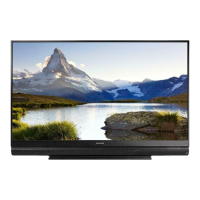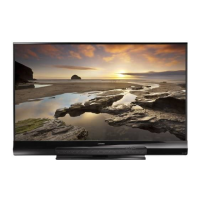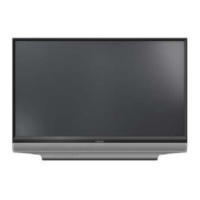
Do you have a question about the Mitsubishi Electric WD-60737 and is the answer not in the manual?
| Brand | Mitsubishi Electric |
|---|---|
| Model | WD-60737 |
| Category | TV |
| Language | English |
General warnings and safety precautions regarding electrical shock and product care.
Guidelines for selecting and using appropriate stands for TV models.
Statement confirming compliance with FCC rules for digital devices.
Section for recording essential TV identification and purchase details.
Notes on proper installation, air circulation, and grounding for safe operation.
Explanation of cooling fans and details on lamp replacement procedures.
Warning against unauthorized software updates to prevent TV damage.
Details on the DLP display system and its resolution capabilities.
Information about the TV's capability to display 3D content.
Explanation of the widescreen format for enhanced viewing experience.
Details on the built-in tuner for receiving over-the-air and digital cable broadcasts.
Description of Component Video and HDMI inputs for various devices.
Feature that automatically recognizes and names connected devices.
Overview of HDMI Control and NetCommand IR Learning capabilities.
List of items included in the TV package for user verification.
Initial setup steps including location, safety, and stand requirements.
Procedure for initial TV power-on and language selection.
Instructions for inserting batteries into the remote control.
Detailed explanation of remote control buttons and their functions.
Description of the physical buttons on the TV set for operation.
Procedures for resetting the TV and releasing panel lock functions.
Explanation of the LED status light colors and their meanings.
Guide to connecting antennas and memorizing channels for reception.
Instructions for connecting and detecting various external devices.
Explanation of the TV's feature for automatic device detection and switching.
Table indicating which TV input jacks activate the auto sensing feature.
Steps to re-enable auto input sensing after an HDMI device is disconnected.
How to navigate the Activity menu to switch between different inputs.
Procedure for tuning channels using the ANT input.
How to select and play content from DVD players or VCRs.
Brief tips on turning the TV on/off and controlling volume.
Guide to adjusting picture settings like mode, brightness, and contrast.
Instructions for changing audio output and adjusting sound settings.
Overview of additional TV functions like 3D Video and NetCommand.
Sections on TV care and obtaining assistance.
Introduction to connection types, auto input sensing, and picture quality.
Recommendations for routing audio for optimal surround sound.
Diagram and description of the TV's primary input/output ports.
Description of additional accessible jacks for easy device connection.
Guidance on connecting devices that output only audio.
Details on connecting antennas and cable services.
Explanation of HDMI inputs, cable types, and HDCP compliance.
Instructions for connecting component video devices.
Instructions for connecting composite video devices.
Description of the emitter for 3D glasses synchronization.
Jacks for audio connection from DVI/PC devices.
Output for sending analog audio to an A/V receiver.
Output for sending digital audio to a receiver.
Output for NetCommand IR emitters (837 series).
Interface for home-theater control devices (837 series).
Port for connecting USB devices for photos and music.
How to switch TV inputs using the Activity menu.
Instructions for setting the TV to turn off automatically after a specified time.
Description of the ChannelView feature and how to use it.
Steps for selecting audio output devices like AV receivers or headphones.
Methods for controlling A/V receiver volume using the TV remote.
Explanation of image definitions like Anamorphic and Non-Anamorphic.
Descriptions of various video signal types (480i, 480p, 720p, 1080i, 1080p).
Explanation of display formats like Standard, Expand, Zoom, and Stretch.
Steps for connecting and configuring 3D video sources.
Instructions for viewing 3D content using the TV and glasses.
How to disable 3D mode for normal viewing.
Methods for connecting computers via DVI and HDMI to the TV.
How to adjust computer video settings like resolution and aspect ratio.
Table showing how computer signals are displayed on the TV.
Information on supported computer resolutions and display capabilities.
Features specific to 837 series for USB media playback.
Overview of the USB media player interface and functions.
Steps to access and use the USB media player menu.
How to control playback of slide shows and music playlists.
Navigation within the thumbnail and playlist views.
Options for configuring slide show and music playback.
Important considerations and tips for using the USB port.
Connecting cameras via composite video for viewing images and video.
Methods for controlling devices connected directly to the TV.
Methods for controlling devices via an A/V receiver.
Overview of the main menu categories and their functions.
Explanation of how to navigate through the TV's menus.
Details on customizing picture settings.
Details on customizing audio settings.
How to reset picture and audio settings.
Adjustments for video mute, audio screensaver, film mode, and smooth 120Hz.
Advanced picture adjustments including PerfectColor and Advanced Picture.
Options for enabling and configuring 3D video.
Guide to selecting picture modes like Brilliant, Game, Bright, Natural, and Special.
Detailed explanations of key picture adjustment parameters.
Adjusting color temperature for optimal picture quality.
Settings for reducing noise in video signals.
Features for enhancing image sharpness and contrast.
Selecting audio output between TV speakers, AV receiver, or headphones.
Adjusting low-frequency, high-frequency, and stereo balance.
Settings for stereo, surround, and mono sound modes.
Options for audio language and SAP selection.
Reducing volume differences between segments.
Explanation of analog closed and text-service captions.
Information on digital captioning and availability.
Settings for font, size, color, and background of digital captions.
Choosing between English and Spanish on-screen menus.
Setting the TV clock, date, time zone, DST, and using the timer function.
Configuring input names and selecting channels.
Procedure for scanning and memorizing channels for reception.
How to manage memorized channels using the Edit menu.
Information on energy saving and lamp settings.
Assigning names to TV inputs for easier identification.
Effects of changing input names on settings and NetCommand learning.
Specific considerations for HDMI device connections and CEC control.
Setting up NetCommand IR control for devices.
Configuring NetCommand IR control for A/V receivers.
Enabling or disabling TV control of CEC-enabled devices.
Personalizing the Activity menu choices.
Explanation of how the TV automatically creates the Activity menu.
Description of Parental Lock, Lock by Time, and Panel Lock features.
Instructions for setting and resetting the TV's pass code.
Using the Other menu for alternate rating systems.
How to temporarily unlock the TV or bypass parental restrictions.
Enabling and configuring parental blocking based on V-Chip and U.S. ratings.
Setting time restrictions for TV use.
Explanation of TV rating levels and content category blocking.
Setting specific times to block TV usage.
Disabling physical TV control buttons.
Managing alternate rating systems and program blocking.
Introduction to NetCommand IR control for 837 series models.
Details on purchasing and using IR emitter cables.
When and how to perform NetCommand setup.
How NetCommand sends signals to control devices.
Steps to set up NetCommand control for a device.
Accessing learned keys via the MORE menu.
How to manage learned keys for NetCommand control.
General steps for operating devices via NetCommand.
Specific methods for Power On/Off, Menu, and Guide functions.
Using the ENTER key for menus and channel selection.
Using ENTER for channel selection with number keys.
Using CANCEL as a Cancel or Exit function.
Using the separator for digital channel numbers.
Accessing device-specific functions with the MORE key.
Steps to switch audio to/from the receiver and control power.
Using the TV remote for volume and mute functions with an A/V receiver.
Procedure to control A/V receiver power and volume with the TV remote.
Key requirements for hearing TV audio through an A/V receiver.
Enabling the A/V receiver to switch inputs automatically.
Setup for sending TV audio to the A/V receiver's designated input.
Setup for sending digital surround sound directly to the A/V receiver.
Procedure for routing video and audio over a single HDMI cable.
Notes on audio connections and NetCommand setup with HDMI.
Completing the HDMI switching setup and learning device inputs.
Using NetCommand to control devices connected via HDMI to the A/V receiver.
Guide to programming the TV remote to control other A/V devices.
Instructions for unlocking parental controls.
Information on controlling CEC-enabled devices via HDMI.
Maintenance and cleaning instructions for the TV.
Common problems and solutions for TV operation.
Overview of functions programmable for VCRs, DVRs, Cable Boxes, A/V Receivers, and CD Players.
How the MORE key accesses additional functions after programming.
Step-by-step guide to programming the remote with device codes.
How to determine the code currently programmed for a mode.
Enabling Audio Lock for A/V receiver volume and mute control.
How to reset the remote to control TV speakers for volume and mute.
Instructions for temporarily unlocking the TV or bypassing parental restrictions.
Steps to enable HDMI Control for CEC-compatible devices.
Troubleshooting steps when HDMI Control is not detected.
Enabling HDMI Control for A/V receivers and connected devices.
Strategies for managing conflicts between CEC-enabled devices.
How to disable TV control for specific CEC devices.
Examples of controlling devices using HDMI Control features.
Steps to remove a device from the Activity menu after disconnection.
Instructions for replacing the TV lamp and cleaning the cartridge.
Recommendation to use genuine replacement lamps.
Detailed steps for removing and installing the lamp cartridge.
Procedure for cleaning the air filter within the lamp cartridge.
Guidelines for cleaning the TV screen, top, and sides.
Tips for maintaining the remote control and troubleshooting low battery.
Overview of different reset functions and their effects.
Information on obtaining service and contacting customer support.
Detailed explanations of Reset, Channel Memorization, Lock, and Auto Input Sensing resets.
Troubleshooting common TV operation issues like fan noise and remote control problems.
Resolving erratic control when HDMI CEC is enabled.
Solutions for channel tuning, access, and ChannelView information issues.
Troubleshooting issues related to TV power on/off and timer functions.
Solutions for common picture quality problems.
Solutions for common sound issues.
Troubleshooting sound issues related to A/V receivers.
Common problems and solutions for NetCommand IR control.
Further troubleshooting for NetCommand IR control issues with A/V receivers.
Details of the limited warranty for parts, software, and labor.
Instructions on how to contact service centers and requirements for warranty claims.
Items and conditions not covered by the limited warranty.
Information on consumer rights and the state governing the warranty.












